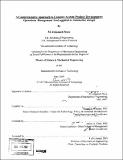A comprehensive approach to complex system product development : operations management tools applied to automotive design
Author(s)
Noor, Muhammad Jehanzeb, 1982-
DownloadFull printable version (16.80Mb)
Other Contributors
Massachusetts Institute of Technology. Dept. of Mechanical Engineering.
Advisor
Daniel E. Whitney and Janice A. Klein.
Terms of use
Metadata
Show full item recordAbstract
The research is based on observations made over a two-year period with the Closures Systems Integrators or CSIs (supervisory engineers who coordinate attribute balance and system decisions for conflicting door attributes) at a North American automobile manufacturer, focusing on organizational and technical improvements in product development. The product development (PD) process for vehicle side doors forms the case study. A Design Structure Matrix model was made of the process by which important closures attributes are managed through PD, Stamping, Manufacturing and Plant Teams. The attribute delivery process is very tightly coupled with many interactions and conflicts between the attributes, and careful system integration and interface management are essential. The study highlights the need for standardized designs and processes to create time for these system-level tasks, along with better knowledge and resource management. Critical inputs for system attributes are identified and it is shown that a lot of rework occurs if these inputs are changed. The Datum Flow Chain method is developed as a way to communicate data, help with assembly decisions and manage interfaces between component owners. (cont.) An investigation of issues experienced at product launch shows that programs with CSIs have fewer design- related problems during launch, but that CSIs still spend too much time on Design and Release-type tasks for components (instead of a system focus) and fire-fighting. An extensive organizational study reveals the need for more leverage and clearer roles and responsibilities of CSIs. Conclusions on the process are supported by a simulation model and interviews with CSIs and many other engineers. Simulation results also show that adherence to official product development schedules timing is inherently difficult due to the structure of the as-is PD process. A brief comparison to Toyota's closures design process is also part of the thesis but was not part of the project itself. Recommendations for improvement include a set of design tasks that should be standardized, types of analytical tools that should be developed and managerial practices to be followed.
Description
Thesis (S.M.)--Massachusetts Institute of Technology, Dept. of Mechanical Engineering, 2007. Includes bibliographical references (leaves 133-135).
Date issued
2007Department
Massachusetts Institute of Technology. Department of Mechanical EngineeringPublisher
Massachusetts Institute of Technology
Keywords
Mechanical Engineering.